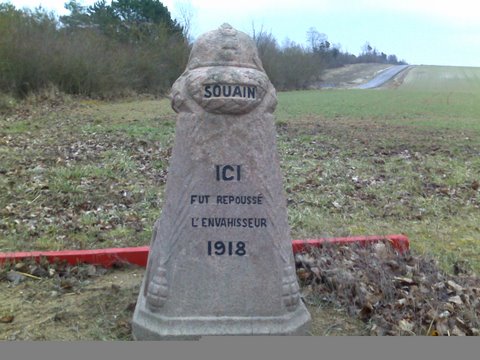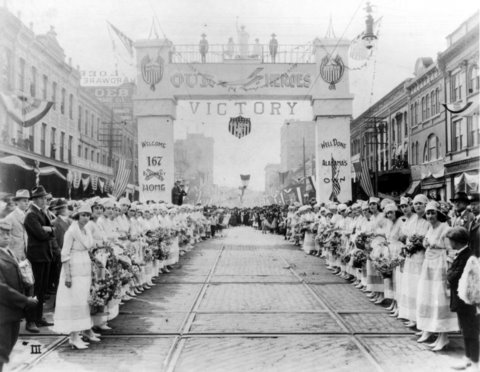167th (Alabama) Infantry Regiment – History
Mobilization of the Alabama National Guard for service on the Mexican border was announced on June 16, 1916. It included five regiments, the largest being the 4th Alabama, and had been created as militia by the Alabama legislature in 1911. Alabamians regarded the 4th Alabama as the descendant of a Confederate unit with the same name and number. There had not been a 4th Alabama between the end of the Civil War in 1865 and 1911.
The newly activated unit was assembled at Vandiver Park, the racetrack in Montgomery, Alabama, in late June, and was placed under the command of Major William Preston Screws, a regular army officer. As a captain he had supervised their earlier training and summer camps since 1913. After mobilization he led the 4th Alabama through basic infantry training at Vandiver Park from July 4, 1916 to October 22, 1916.
Major Screws then took about 1,300 officers and men by train to Nogales, Arizona and conducted advanced infantry training there until March, 1917. The regiment returned to Montgomery and performed guard duty for a month and a half at railroad and industrial sites throughout Alabama.
Upon entering the war on April 6, 1917, the regiment’s authorized strength for rifle companies was increased from 65 men to 150, then to 250. Other Alabama National Guardsmen were integrated into the 4th to bring it to 3,720, including 112 officers. The Guard had a total force of about 5,000 at that time. Many of those not selected to be included in the 4th were sent to Macon, Georgia to become the nucleus of the 31st (Dixie) Division.
On August 14, 1917 the War Department published an order changing the name of the 4th Alabama Infantry Regiment to the 167th United States Infantry Regiment. William Preston Screws, after having only briefly held the rank of Lieutenant Colonel, was promoted to Colonel and given command of the expanded and newly named regiment. On the next day it was announced that the command would become part of the 42nd “Rainbow” Division and on August 28, 1917 a force of 3,677 officers and men left Montgomery on eight trains for Camp Mills on Long Island to join its new division.
The “Rainbow” Division organized and trained on Long Island for little over a month. In October it started moving by ship to England and France. The Alabama regiment began its movement on November 7, 1917.
Delegations from France and Great Britain had appealed to the US for placement of American infantry in their armies on the European battlefields. They argued that their armies had officers experienced in fighting while the US officers had none. The French asked for 75 battalions. President Wilson and General Pershing rejected the appeals, insisting that the AEF fight as an American army, confident that their officers would rise to the occasion.
The Allies were making no gains when the 167th (Alabama) reached France. It was a low point of the war for them. Every major offensive had failed. Most believed the outcome of the war would not be decided until the full force of the Americans was felt, probably in 1919.
After reaching France and receiving some specialty training from the French and a few newly established American schools, the 167th (Alabama), like all of the 42nd Division, was twinned with French units in the Lunéville sector of Lorraine in February, 1918. The “Rainbow” was the third US Division to reach France. Engaging the Germans in trenches, on raids and in patrol action in Lorraine quickly brought it to veteran status in the eyes of anxious French, American and German observers.
During March of 1918 the Allies were outnumbered by Germans in France, but by the end of May more than 600,000 Americans had reached the war zone. In July the Allies outnumbered Germans by 200,000 men. Without that surge the Allies would have been outnumbered by 400,000.
The Americans kept coming.
On June 21, 1918 Supreme Commander Foch asked General Pershing to move the “Rainbow” Division to the Champagne-Marne to help the French in the coming battle to save Paris. The entire 42nd Division took part in that defense that stopped the German “Peace Offensive” on July 15, 1918. The brunt of the Central Powers assault in this part of the Champagne offensive was taken by the 167th (Alabama) Infantry Regiment and the 109th French Regiment. For that battle, Colonel Screws replaced Major Hartley A. Moon as commander of his 2nd Battalion with Captain Everett H. Jackson, placing Jackson’s PC in the command post of his French counterpart. It was the first change of leadership in the Alabama regiment and all three battalions of the 167th were deemed by French commanders to have fought fiercely and well.

This marker, topped by the Adrian helmet used by the French troops in the second half of WWI, commemorates the place where Allied troops stopped the German during the Champagne battle. The marker is placed at about the height of the Intermediate Line where two French companies and Companies E and F of the Alabama 167th withheld severe attacks launched by the Germans.
General Gouraud said that the “Rainbow” put a new spirit into France.
Foch immediately put the victorious Allied Army on the offensive. Four days after winning in the Champagne, he ordered a Franco-American drive northeast from the town of Château-Thierry. The 167th (Alabama), with its sister regiment in the 84th Brigade, the168th (Iowa) on its right flank, led the “Rainbow” Division push into a great battle at Croix Rouge Farm on July 26, 1918. There the Alabama regiment lost 162 killed, including 3 Lieutenants and 2 Captains, company commanders. More than 1,000 from the 167th (Alabama) were wounded. But their victory forced the Germans to retreat to positions on the east of the Ourcq River, about six miles from the Croix Rouge Farm.
On the next day, July 27, the weakened 167th (Alabama) and 168th (Iowa) regiments of the 84th Brigade were joined by the “Rainbow’s” fresh 83rd Brigade. Regiments abreast, the full “Rainbow” Division attacked across the Ourcq River on the morning of July 28, and opened the battles on the hills east of the river. Corporal Sidney Manning of Company G of the 167th (Alabama) was recommended for the Congressional Medal of Honor for his heroic work in that morning’s attack.
The regimental operations officer, Captain Mortimer H. Jordan, M.D. was wounded that day and died in a field hospital. Command of F Company, Gadsden, passed twice that morning due to wounds. Command of G. Company, Ozark, passed due to wounds. Command of the combined 1st and 3rd battalions was passed from Major Dallas B. Smith to Captain Ravee Norris. Lieutenant Colonel Bare, regimental executive officer was gassed and evacuated. Major Carroll took over command of the forward PC from him but was wounded. Captain Herman W. Thompson, commanding H Company, was seriously wounded and evacuated.
The 84th Brigade’s commander, Brigadier General Robert A. Brown was relieved during the battle by Colonel Douglas MacArthur on the recommendation of Major General Menoher, commander of the “Rainbow.” The 168th (Iowa) regiment’s commander, Colonel E. R. Bennett, was replaced by Lieutenant Colonel Mathew A. Tinley. An Iowa battalion commander was also replaced.
After four days of hard fighting by both sides, the Germans began a massive retreat toward the Rhine River on August 2, 1918. Casualties in this operation for the “Rainbow” were 184 officers and 5,469 men.
The 42nd Division, reequipped and brought back to full strength, was ordered to take part in the all American attack at St. Mihiel. After more than a week of night marches to the jump off position, the division attacked on September 11, 1918, delivering the main blow in the direction of the heights overlooking the Madine River. Just as at the Croix Rouge Farm, C Company and D Company of the 167th (Alabama) led the “Rainbow” assault force. The attack was a total surprise to the Germans and came at a time when they had begun to retreat. The 167th objective was accomplished by nightfall of the first day. Thirteen American divisions, about half a million men, took part in the highly successful operation.
The 42nd then moved sixty miles to join the million men of the 1st US Army massing for the attack in the Argonne. The operation fell three weeks behind the schedule that General Pershing had agreed to with Generalissimo Foch: its October 4, 1918 attack was pushed back and the Americans retreated for the first time in the war. Battle tested American divisions were brought into the battle. On October 11, the “Rainbow” replaced the exhausted 1st US Infantry Division, “the Big Red One”, which had lost 1,750 killed in a week long unsuccessful attempt to penetrate the Kriemhilde Stellung of the Hindenburg Line at the Côte de Châtillon.
The “Rainbow” attacked there with all regiments abreast on October 14, 1918. The 166th (Ohio) and the 165th (New York) regiments were forced to pull back. Lieutenant Colonel William “Wild Bill” Donovan had remained on the point of the 165th until wounded and gaining a recommendation to receive the Congressional Medal of Honor. On October 15 the 83rd Brigade commander was relieved and the commander of the 165th (New York) regiment was relieved.
The burden of taking the Côte de Châtillon shifted entirely to the infantry of the Alabama and Iowa regiments. The 3rd Battalion of the 167th (Alabama) had taken up the point of the attack at the base of the Côte, Hill 260. It made no progress on the first or second days (October 14 and 15). Its soldiers suffered without shelter other than a wet blanket.
Also under constant fire in the rain and mud, the 1st Battalion of the 168th (Iowa) gained high ground at Hill 288, on October 15. With heavy casualties and through hard fighting it created a position on the forward slope from which it could cover the assault of the 3rd Battalion of the 167th (Alabama) on October 16, 1918. Also key to that attack was the concentrated fire for 45 minutes, about a million rounds, from the 151st (Georgia) Machine Gun Battalion from the forward slope of Hill 263. Major Cooper D. Winn, Jr. had personally placed every gun and assigned targets. Elements of the Alabama and Iowa regiments closed on the German position at the Côte de Châtillon at the same time and held it against a counterattack, sharing equal honors. Private Thomas S. Neibaur of M Company of the 167th (Alabama) was awarded the Congressional Medal of Honor for his service in the assault.
Moving to Sedan, the Alabamians, along with the entire 42nd Division, took part in the general attack until the war ended on November 11, 1918.
The regiment entered Germany and served in the Army of Occupation in Sinzig.
After five months of occupation duty, some training, fraternizing and sightseeing, it traveled by rail to Brest, France and sailed for home on April 25, 1919. Returning to Camp Meritt, New Jersey, the “Rainbow” dispatched all units to home states for discharge.
The Alabama troops left for home by train on May 7, 1919 and were honored by triumphal parades in Gadsden, Anniston, Birmingham, Montgomery and Mobile before being discharged at Camp Shelby, Mississippi.
See a List of of the 167th Alabama Infantry Regiment




